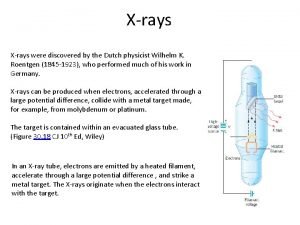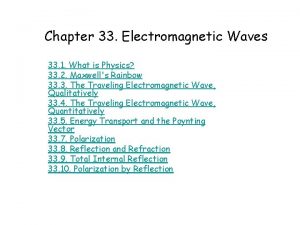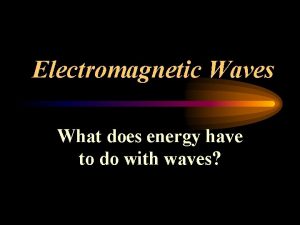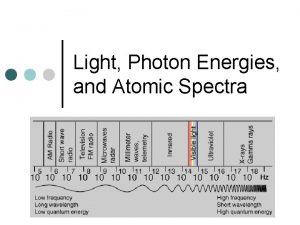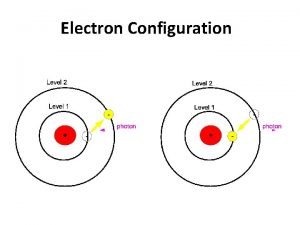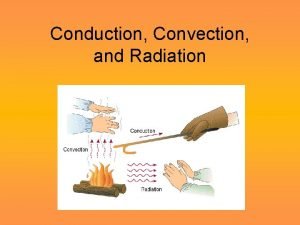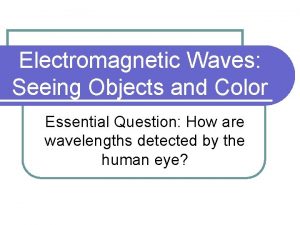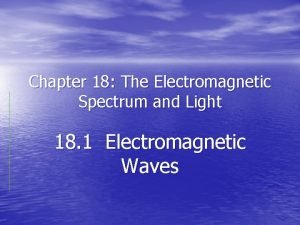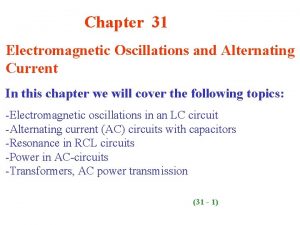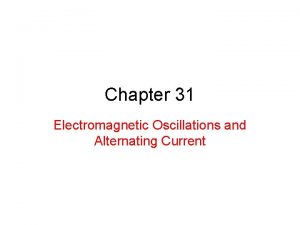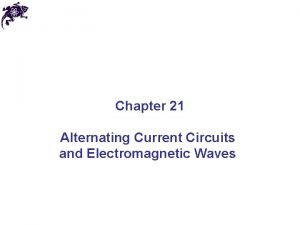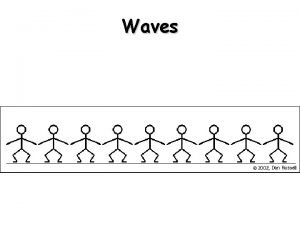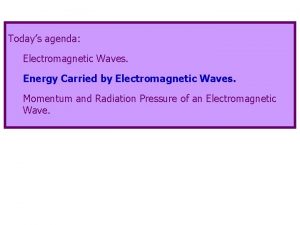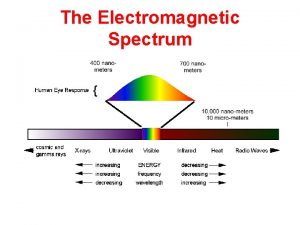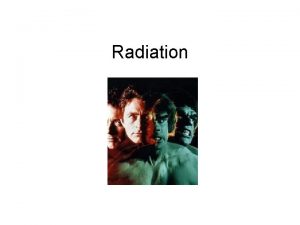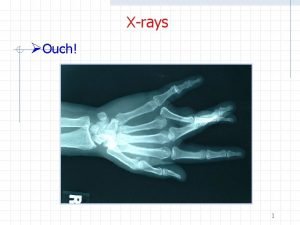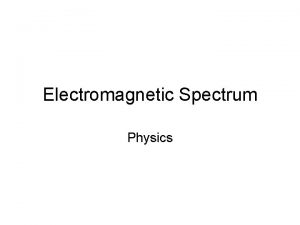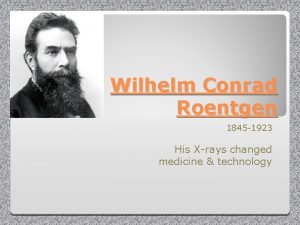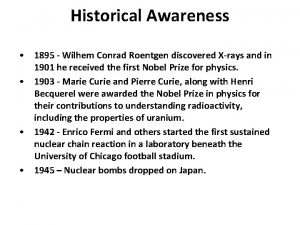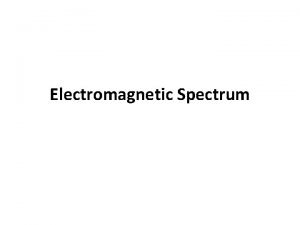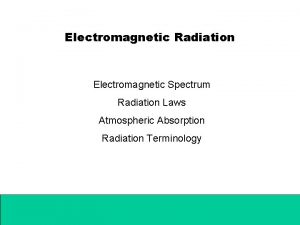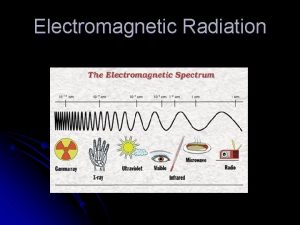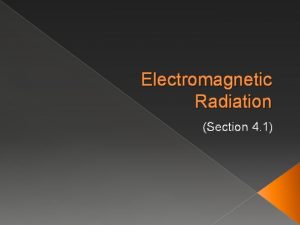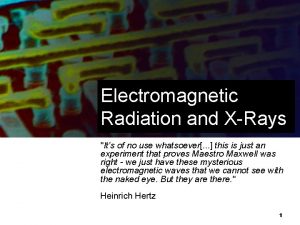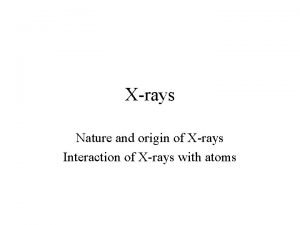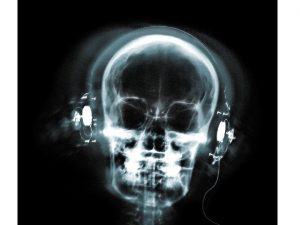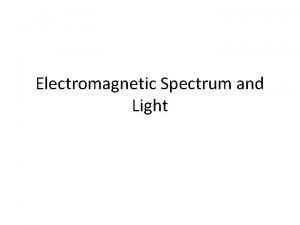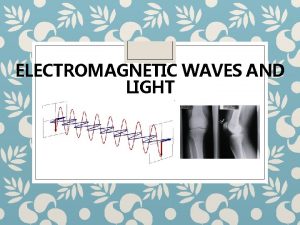Radiation Electromagnetic Radiation Xrays Roentgen and famous picture





































- Slides: 37

Radiation

Electromagnetic Radiation

X-rays Roentgen and famous picture of his wife’s hand William Roentgen German Physicist - 1895 • Was working with cathode ray tubes when he noticed that a phosphorescent material in his lab was glowing several meters away. • He made a phosphorescent screen and was shocked when he put his hand in front of the screen – he could see the outline of his bones!! • He did not know what kind of rays were responsible for this phenomenon so he called them X-rays

Electromagnetic Spectrum (of waves) • (x-rays were part of EM spectrum) • Light, heat (infra-red), microwaves, ultraviolet, x-rays, gamma rays and radio waves are all just energy waves of different frequencies. • The sun emits radiation across the EM spectrum

Anatomy of a Wave

Frequency and Wavelength • Frequency (f ) - the number of waves that go by each second (Hertz – Hz) • Wavelength (λ) - the length of one complete wave. (eg. Radio waves from station 95. 3 MHz, 95 300 000 waves go by each second a wave length of about 3 m)

Electromagnetic Spectrum Low Frequency Low Energy High Frequency High Energy

Summary of EM radiation • All EM radiation travels at the speed of light (3. 0 X 108 m/s) • Frequency is proportional to Energy • Frequency is inversely proportional to wavelength • EM radiation has NO MASS and can travel without particles

Particle Radiation

Discovery of Radioactivity Henri Becquerel French Physicist • Becquerel put different elements in the sun and then placed them on photographic plates in dark drawers to study phosphorescence. • One day in 1896 there was no sun and he put Uranium on a photographic plate in a dark drawer. The next day the plate was cloudy! Energy was coming from Uranium itself!

Discovery of Radium and Polonium • Marie and Pierre Curie spent years purifying radioactive elements. • They discovered new radioactive elements Radium and Polonium in 1898. Marie and Pierre Curie of Poland France

Three types particle radiation • Rutherford found three different types of particles were emitted. • He called them alpha( ), beta( ) and gamma(γ) particles Ernest Rutherford New Zealand

Penetrating ability of particles • alpha particles stopped by paper • beta particles stopped by 5 mm of aluminum • gamma rays stopped by 30 cm of dense lead

Charge on three types of radiation In a magnetic field • Alpha particles deflected one way, • Beta particles deflected the other way • Gamma rays not deflected at all. γ(0) (+) (-)

Spontaneous Radiation Summarized + + - Type of Radiation Alpha particle Beta particle Gamma ray (EM) What is it? Helium Nucleus Electron Photon Symbol g Mass (atomic mass units) 4 1/2000 0 Charge +2 -1 0 Speed slow fast speed of light Ionizing ability high medium indirectly low (paper) medium (5 mm of aluminum) high (30 cm lead) Penetrating power

Where does all of this radiation come from? Radioactive Atom Ionizing Radiation alpha particle X-ray beta particle gamma ray

Radiation Types Clarified + • Particle radiation + consists of particles that have mass. ie. alpha or beta particles. • Electromagnetic Radiation consists of massless waves/photons of higher and lower energies. ie. X-rays, gamma rays, light, radio waves, UV, IR, microwaves

Structure of the Atom (review) • Atoms all contain a dense nucleus with protons and neutrons. • Elements are arranged on the periodic table ONLY by the number of protons in the nucleus • Electrons travel around the nucleus and attempt to balance the charge from the protons.

Isotopes • Isotopes are elements with the same number of protons and a different number of neutrons eg. Carbon-12 and Carbon-14 (this is also the charge on the nucleus)

Stable Isotopes • Elements can only accept certain numbers of neutrons. Too many or too less, and elements become unstable and will decay (orange) or not form at all (white)

Radioactive Decay • Radioactive decay is the spontaneous decay of atoms by emitting alpha, beta or gamma particles. • New elements are always formed during alpha and beta decay • (This is the sort of thing that happens with radioactive waste)

Alpha Decay

Beta Decay • Beta decay involved the ejection of a beta particle (could either be an electron or a positron) • Electrons come from a neutron and change it to a proton!!

Gamma Decay • The “*” denotes high energy • Gamma rays are emitted when a particle has too much energy. No new elements are formed.

Sources of Gamma Rays • Supernova explosions, neutron stars, and black holes are all sources of celestial gamma-rays

Balancing Nuclear Equations • Both MASS and CHARGE must be conserved in any nuclear reaction • This means that the sum of masses and atomic numbers on the right and left sides of the equations must be equal! eg. The decay of Uranium-238:

Balancing examples:

Half Life • The half-life is the amount of time it takes for half of the unstable atoms in a sample to decay. • The half-life for a given isotope is always the same no matter how many particles you have or what happened in the past. • For example, if an element has a half life of 4 days and starts off with 16 g of unstable particles, then after the first four days, 8 g will remain. After the next four days, 4 g will remain. After four more days, 2 g will remain etc.

Decay applet

Carbon-14 Dating • Cosmic rays change Nitrogen-14 in to Carbon-14 in the atmosphere. This radioactive form of Carbon-14 is absorbed into organisms through carbon dioxide. • Once the organism dies, the carbon slowly decays to nitrogen 14 • The half-life of carbon-14 is about 5730 years.

How it works

Uses of Radiation • • • Pet Scans – Uses positrons to get moving 3 d image by reacting with radioactive injections Cat Scans – 3 D X-ray image X Rays (do not include Cat Scans) Food irradiation Tracers, leakage, and wear in industry, density and thickness measurements Cancer Treatment Activation analysis, crime solving – composition determining using spectrometry Smoke detectors Microwave ovens Cell/mobile phones

The dangers of radiation

Ionizing radiation

The Dangers of Radiation • Both high frequency electromagnetic radiation and particle radiation can ionize atoms (give them a charge). • Ionized atoms can change the DNA leading to the reproduction of cancerous cells • Types of ionizing radiation include alpha, beta (particle), gamma, x-rays and neutrons (EM).

Genetic Changes

How do we measure radiation? Geiger Muller Tube (Geiger Counter) • Has a large cylindrical cathode (positive electrode) and a tungsten anode (negative electrode) with a voltage across them. • When alpha, beta or gamma radiation ionizes a gas particle, the positive ion moves to the cathode and the electron moves to the anode, thus sending a signal to the counter.
 Roentgen si unit
Roentgen si unit Frequency of xrays
Frequency of xrays Who discovered xrays
Who discovered xrays Jfk xray
Jfk xray Wilhelm k roentgen
Wilhelm k roentgen Cathode-ray tube
Cathode-ray tube Wilhelm roentgen atomic theory
Wilhelm roentgen atomic theory Intensity of em wave is
Intensity of em wave is Facts about electromagnetic radiation
Facts about electromagnetic radiation Wavelength formula electromagnetic wave
Wavelength formula electromagnetic wave Types of radiation in the electromagnetic spectrum
Types of radiation in the electromagnetic spectrum Vertical physics
Vertical physics Which telescope detects invisible electromagnetic radiation
Which telescope detects invisible electromagnetic radiation Sound is a transverse wave true or false
Sound is a transverse wave true or false Em waves spectrum
Em waves spectrum When electromagnetic radiation of wavelength 300
When electromagnetic radiation of wavelength 300 Sub orbitals
Sub orbitals Example of radiation
Example of radiation Picture 1 picture 2
Picture 1 picture 2 What waves do not require a medium
What waves do not require a medium Mechanical waves examples
Mechanical waves examples Difference between electromagnetic and mechanical waves
Difference between electromagnetic and mechanical waves Difference between matter waves and electromagnetic waves
Difference between matter waves and electromagnetic waves Mechanical waves vs electromagnetic waves
Mechanical waves vs electromagnetic waves Similarities of mechanical and electromagnetic waves
Similarities of mechanical and electromagnetic waves Electromagnetic waves: seeing objects and color
Electromagnetic waves: seeing objects and color Chapter 18 electromagnetic spectrum and light
Chapter 18 electromagnetic spectrum and light Electromagnetic oscillations and alternating current
Electromagnetic oscillations and alternating current Electromagnetic oscillations and alternating current
Electromagnetic oscillations and alternating current Alternating current circuits and electromagnetic waves
Alternating current circuits and electromagnetic waves What do all waves transmit
What do all waves transmit Electromagnetic braking system
Electromagnetic braking system How is gravity and electromagnetic forces alike
How is gravity and electromagnetic forces alike A health inspector is measuring the intensity of a sound
A health inspector is measuring the intensity of a sound Electromagnetic energy
Electromagnetic energy Energy density in em waves
Energy density in em waves Which colour has the longest wavelength
Which colour has the longest wavelength Waves are produced by stars and galaxies.
Waves are produced by stars and galaxies.




